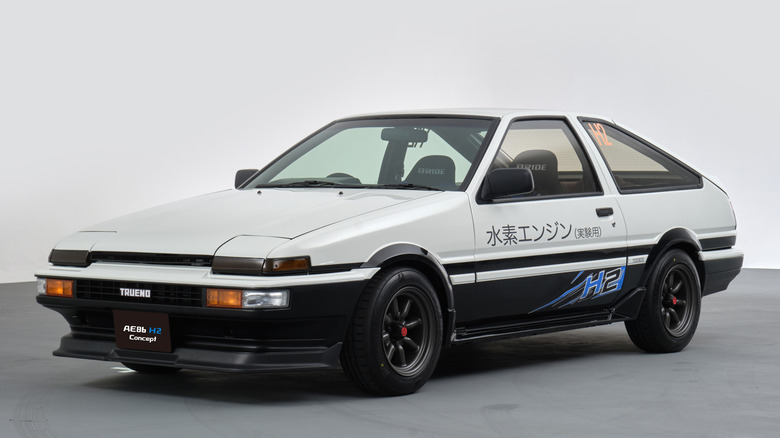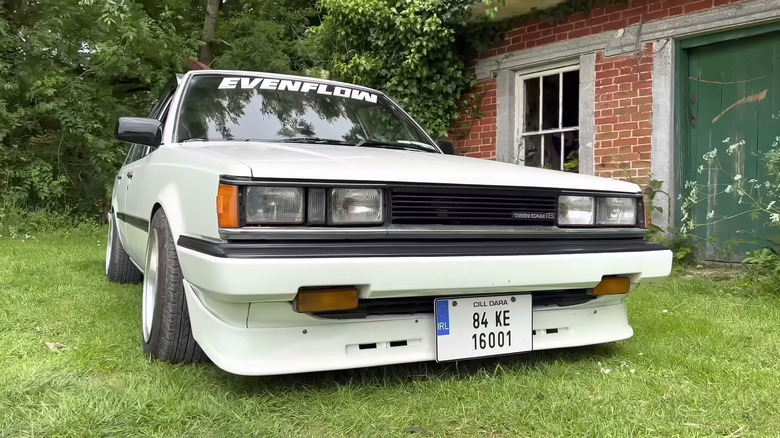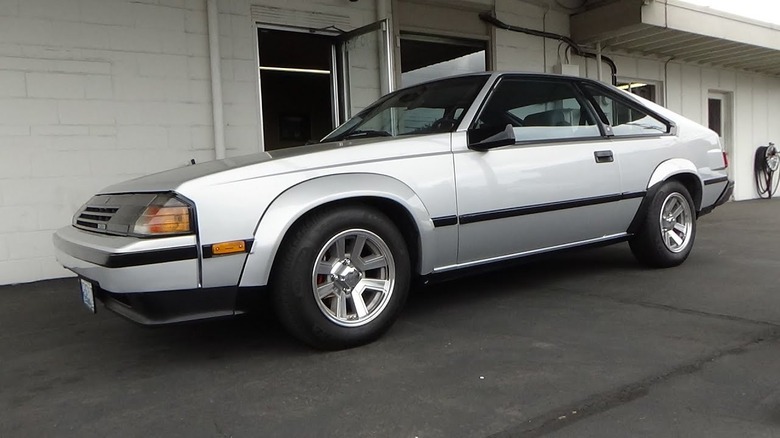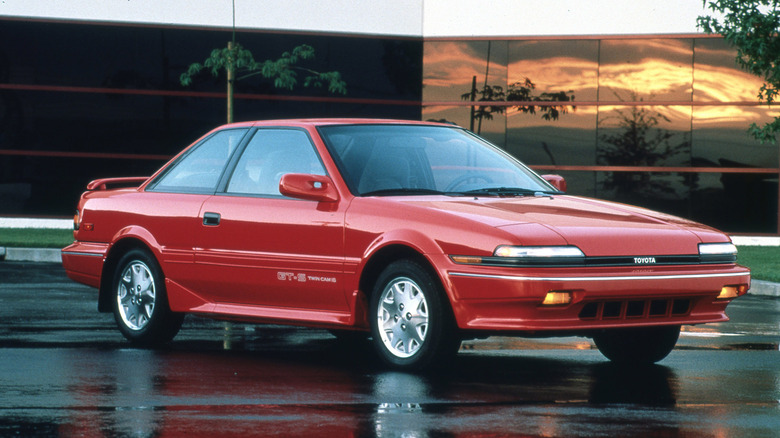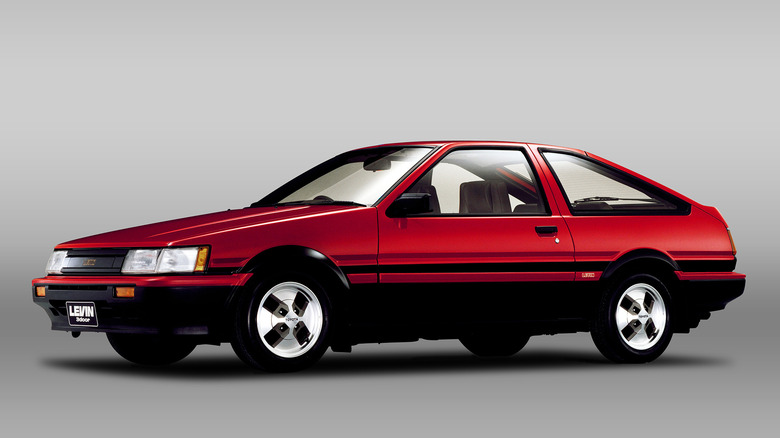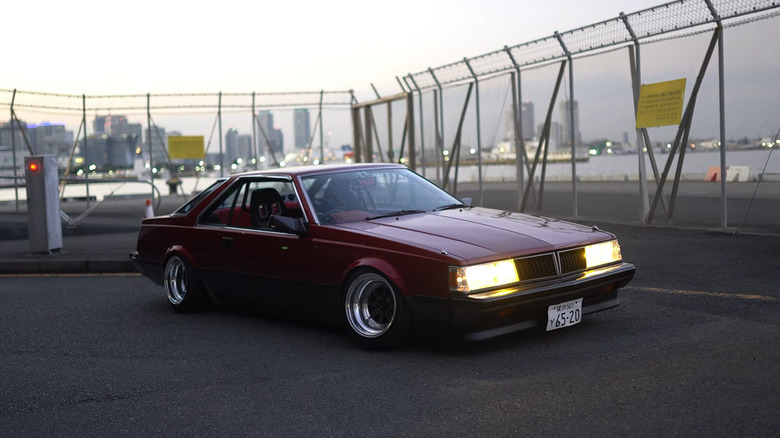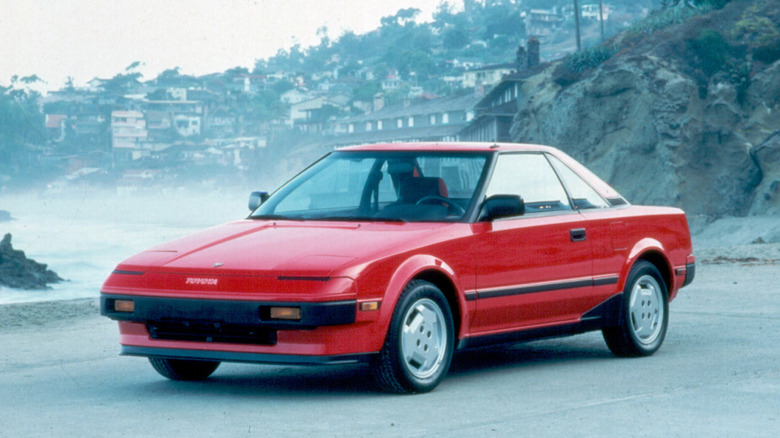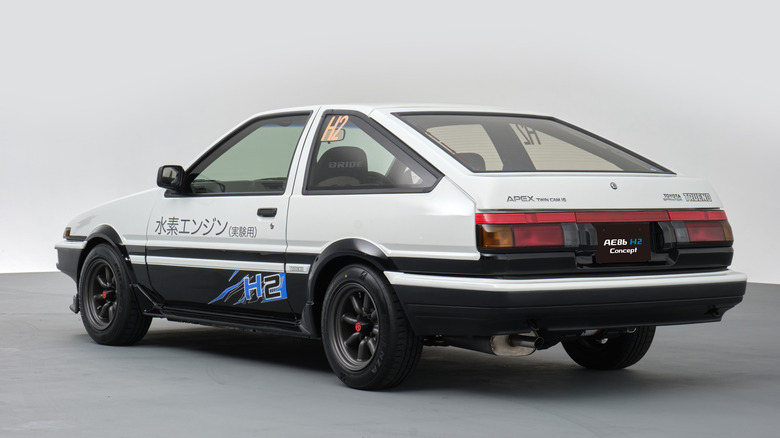Every Toyota Model Powered By The 16-Valve 4A-GE Engine
Few engines captivated as many automotive enthusiasts as Toyota's 4A-GE engine. Sure, Ferrari's classic Colombo V12s are the talking point among deep-pocket collectors, and JDM's inline-6 powerhouses are a staple in the high-horsepower race, but all of those are unattainable for the average car aficionado. What the common enthusiast dreams about is small engines that can bring a smile to the face, and the 16-valve 4A-GE fits that bill perfectly.
The biggest attraction in the 4A-GE circus is its high-revving nature, which — apart from its solid power numbers — brought racecar-like sounds to regular Toyotas. Despite that obvious appeal, perhaps the most important aspect of this 1.6-liter masterpiece is its flexibility. Unlike most other performance engines, the 4A-GE will fit just about any drivetrain configuration. Want a rear-wheel-drive fun machine powered by a 4A-GE? No problem. Maybe a front-wheel-drive hot hatch? Also, possible. There is even a mid-engine sports car with the 4A-GE!
This compliance with various types of Toyota sports cars made the 4A-GE desirable among different groups of enthusiasts. It's one of Toyota's magnum opus motors, encompassing most of its performance vehicles in the 1980s and 1990s. Heck, an 11,000-rpm 4A-GE even powered Formula Atlantic cars –- that's how versatile this tiny unit is. However, in this article, we will focus on all production cars powered by the first three generations of the engine with four valves per cylinder. So, brace yourselves because every 4A-GE ride is a wild ride!
Toyota Carina (1983 to 1992)
The Carina isn't widely known in North America, but it was Toyota's mid-size offering overseas — similar to the Camry. Unlike the sedan North American buyers could buy, the Carina was equipped with some interesting powertrain options, particularly the JDM models. The iconic 1.6-liter 4A-GE was available in the 1983 Carina GT-R, producing 130 hp at 6,600 rpm. However, that was not the most powerful version, as Toyota also offered a 1.8-liter Twin-Cam turbocharged engine producing 158 hp.
What makes the 1983 Carina even more interesting, though, is the fact that it was the last generation on an RWD platform. Imagine it as a more grown-up AE86 with all of its drifting potential, albeit with space for your whole family. It even came standard with a five-speed manual, confirming that parents in the past had more fun driving their kids to school.
Unfortunately, in an effort to make more fuel-efficient and spacious vehicles, Toyota slowly shifted to front-wheel-drive platforms in the 1980s. Thus, the next generation 1988 Carina lost the driver's appeal of the previous model, though it was roomier and more luxurious. Still, the Japanese automaker at least continued to offer the 4A-GE as an option. Initially, the engine produced 118 hp, but in 1989, it was replaced with a more powerful 138 hp version. Crucially, it came standard with a five-speed manual, which surely made winding up the 4A-GE much more enjoyable.
Toyota Celica (1983 to 1989)
The RWD Carina is certainly a hidden JDM gem, but the four-door sedan body style might be a bit too much for some. No worries, because Toyota also made a coupe version of the same car. You might know it as the Celica, which was once Toyota's pony car for the masses. Yup, when the Celica was in its third incarnation, it was also a rear-wheel-drive sports car! Further, since Toyota has always been good at part sharing, the third generation JDM Celica was eventually offered with a 124 hp version of the 4A-GE. Meanwhile, all North America got was a low-revving 2.4-liter unit with 96 hp. Ouch!
The third generation Celica didn't become as popular as the AE86 despite sharing the same recipe. Maybe that was because it was a bigger vehicle, more along the lines of a grand tourer rather than a lightweight sports car. Still, that would be understating its potential and importance, as it also brought some advanced features to the table. Notably, there was an optional active suspension on some models, as well as four-wheel steering. These are features that are optional even today and certainly impressive for the era.
For the fourth generation model, Toyota regrettably moved the Celica to a front-wheel-drive platform, with the 4A-GE again being available as an option in Japan. Still, this is when the Celica was shaping up to become a rally icon, so the range-topping version was the GT-Four model with full-time 4WD and 182 hp coming from a 2.0-liter turbocharged engine.
Toyota Corolla Front-Wheel-Drive Applications (1984 to 1993)
Rear-wheel-drive Corollas equipped with the 16-valve 4A-GE engine are in vogue, and rightfully so. However, diminishing their front-wheel-drive counterparts just on drivetrain alone would be silly, as there are some Toyota hidden gems to be found there, such as the North American 1987 Corolla FX16. A VW Golf GTI rival, the FX16 offers the high-revving nirvana of every other 4A-GE car, albeit in a smaller and lighter package. It only has 108 hp, but it redlines at 7,500 rpm and weighs a meager 2,141 lbs. As always, the Japanese versions had more power, with 128 hp available in the FX-GT.
Not a fan of hot hatches? Then, maybe the 1989 Corolla GT-S Coupe takes your fancy. With its angular design and pop-up headlights, it will attract much more attention than the FX16. It only had 115 hp, sure, but again, it is lighter than any modern car at 2,372 lbs. You also get to rev it out and listen to its rewarding tune. Want more power? Toyota offered a supercharged 4A-GZE version in its domestic market, producing 163 hp.
Sure, the FX16 and GT-S Coupe don't have the drifting abilities of the AE86, and they don't enjoy as much aftermarket support, making them less appealing to enthusiasts. Still, they are much cheaper and offer a more analog experience than any modern sports car.
Toyota Corolla Rear-Wheel-Drive Applications (1983 to 1987)
The rear-wheel-drive AE86 Corollas equipped with the 4A-GE engine are so iconic that they deserve a spot on this list all to themselves. From bringing driving fun to the masses to giving birth to an entirely new category of racing, the AE86 cars earned their place in the pantheon of automotive greats. The formula behind their success was simple — lightweight chassis, rear-wheel drive, and a high-revving engine.
The Corolla version of the AE86 (the Sprinter was a different model) was called the Levin and had fixed headlights. It was the last rear-wheel-drive Corolla, co-existing with the front-wheel-drive fifth generation model. That was quite the power move – regular buyers could opt for a roomier and more efficient FWD Corolla, while enthusiasts had a fun-to-drive RWD option. It's one of the reasons why the fifth generation model is our favorite Corolla generation.
Technicalities aside, the AE86 Corolla is a blast to drive, particularly from a modern perspective. It's featherlight at 2,140 lbs with almost no inertia and has a perfect handling balance. This means you can drive it surgically in a motorsport fashion or twerk the rear end like Keiichi Tsuchiya, the drift-king that established the discipline with this particular vehicle. The AE86 communicates with the driver, too, and its 128 hp 4A-GE combined perfectly with the five-speed manual.
If only the AE86 Corolla was as attainable today as it was in the 1980s. Prices are getting out of hand, and that probably won't change soon. The AE86 still has its merits, but it's an old car that will give you headaches to go with the smiles. Not that this stops enthusiasts from dreaming of owning one!
Toyota Corona (1983 to 1988)
The Corona is where things might start to get confusing. Like many JDM Toyotas, the Corona was based on a shared platform — Carina and Celica – but aimed at a slightly older demographic. In North America or Europe, this strategy would never succeed, but even today, Toyota offers different models that would just be different trims in other markets.
Still, the Corona had its merits. Like the Celica, it got the 16-valve 4A-GE in RWD and FWD form. The older RWD coupe model, the T140, is certainly more interesting, as it offered AE86-like drifting thrills, albeit in a more upmarket package. Its angular 1980s JDM styling also has that manga vibe to it, particularly when lowered to the ground. Like the JDM Celica, it had all the ingredients to make you happy — 4A-GE, a five-speed manual, low weight, and a four-wheel independent suspension. Heck, there was even a 158 hp turbocharged 1.8-liter engine available.
The seventh generation Corolla was also available as a front-wheel-drive model, and it shared this platform with the fifth generation Celica. The coupe version was available with the 128 hp 4A-GE and a five-speed manual, weighing 2,337 lbs. It also received suspension reinforcements, like a performance rod added to the strut towers, for more responsive handling. Meanwhile, the streamlined notchback and coupe body was more aerodynamic, giving it a reduced drag. So, a cool vehicle, but its lack of personality probably got in the way of it becoming a more respected JDM classic.
Toyota MR2 (1984 to 1989)
In the 1980s, if you wanted mid-engine balance, you basically needed to sell your house and splurge the cash for a Ferrari or Lamborghini. Cheaper British and Italian sports cars and roadsters were all front-engined — midship cars were seen as the domain of the exotics. Toyota wanted to change that with the MR2, an abbreviation for Midship Runabout 2-seater. A small and lightweight mid-engine sports car, the MR2 brought supercar driving thrills to the masses, spiced up with Toyota's legendary reliability and efficiency.
Of course, Toyota's first mid-engine sports car was powered by a 4A-GE engine in most markets. The first Mk1a iteration, available from 1985 to 1987, got the 112 hp Blue Top version, which was later replaced with the 122 hp Red Top for the facelifted Mk1b model, which was produced from 1987 to 1990. However, the pick of the bunch was actually the supercharged 4A-GZE engine. The boosted unit peaked at 145 hp and had a much higher 140 lb-ft of torque, enough for a 0-60 mph time of just 6.5 seconds. Oh, and it retained the 7,500-rpm redline.
However, while certainly quick for the era, the MR2 was even more impressive when you took the numbers out of the equation. With its slick-shifting five-speed manual, low 2,396 lb curb weight, and excellent handling balance, the MR2 has set the stage for the next generation model, which has become a much more serious sports car. Still, with its angular design, pop-up headlights, solid reliability, and the mid-mounted 4A-GE, the MR2 remains an attractive proposition for enthusiasts even today.
Toyota Sprinter (1984 to 1992)
For many JDM enthusiasts, Takumi Fujiwara is a link to drift culture and the joy of driving in general. If you're unfamiliar with the name, Takumi Fujiwara is the main protagonist in "Initial D," a Japanese anime series. There, he drives his father's AE86 Toyota Sprinter Trueno GT-APEX to deliver tofu and race various JDM legends at Mount Haruna (referred to as Mount Akina in the series) all while showcasing his racing and drifting skills.
"Initial D" is a fun anime, especially if you like JDM sports cars, but its impact on the automotive culture is much, much bigger. The anime not only launched the AE86's popularity into the stratosphere, but it popularized drifting as a standalone racing discipline. That is, of course not surprising because Keiichi Tsuchiya, the drift king himself, was a technical director in the early stages of development of the series.
What might be confusing to some is the naming of the car. While the rest of the world got the Corolla AE86, in Japan, there were two different models that carried the same code: Sprinter Trueno and Corolla Levin. They both were basically the same cars, equipped with the same 16-valve 4A-GE producing 128 hp, though with some cosmetic differences. Still, the Sprinter Trueno, available in liftback and notchback form, is the more desirable model today due to the sharper front end with pop-up headlights. Other than that, they are the same lightweight and overpriced (today) RWD fun machines.
